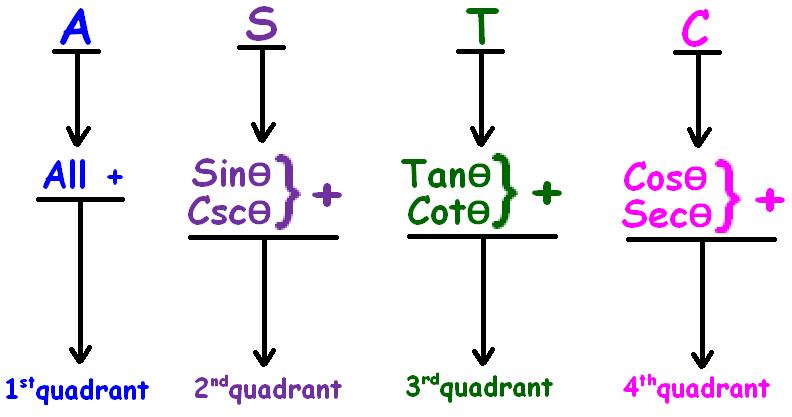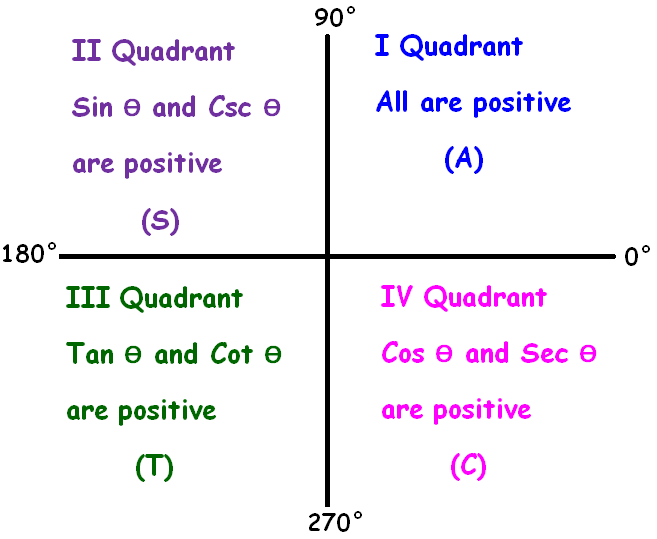TRIGONOMETRIC RATIOS OF SUPPLEMENTARY ANGLES
Subscribe to our ▶️ YouTube channel 🔴 for the latest videos, updates, and tips.
Two angles are supplementary to each other if their sum is equal to 180°.
Trigonometric-ratios of supplementary angles are given below.
|
sin(180° - θ) = sinθ cos(180° - θ) = -cosθ tan(180° - θ) = -tanθ csc(180° - θ) = cscθ sec(180° - θ) = -secθ cot(180° - θ) = -cotθ |
sin(180° + θ) = -sinθ cos(180° + θ) = -cosθ tan(180° + θ) = tanθ csc(180° + θ) = -cscθ sec(180° + θ) = -secθ cot(180° + θ) = cotθ |
Let us see, how the trigonometric ratios of supplementary angles are determined.
To know that, first we have to understand ASTC formula.
The ASTC formula can be remembered easily using the following phrases.
All Sliver Tea Cups
or
All Students Take Calculus
ASTC formula has been explained clearly in the figure given below.

More clearly

From the above picture, it is very clear that
(i) (180° - θ) falls in the second quadrant and
(i) (180° + θ) falls in the third quadrant
In the second quadrant (180° - θ), sin and csc are positive and other trigonometric ratios are negative.
In the third quadrant (180° + θ), tan and cot are positive and other trigonometric ratios are negative.
Important Conversions
When we have the angles 90° and 270° in the trigonometric ratios in the form of
(90° + θ)
(90° - θ)
(270° + θ)
(270° - θ)
We have to do the following conversions,
sinθ <----> cosθ
tanθ <----> cotθ
cscθ <----> secθ
For example,
sin(270° + θ) = -cosθ
cos(90° - θ) = sinθ
For the angles 0° or 360° and 180°, we should not make the above conversions.
Evaluation of Trigonometric Ratios Using ASTC Formula
Example 1 :
Evaluate :
sin(180° - θ)
Solution :
To evaluate sin(180° - θ), we have to consider the following important points.
(i) (180° - θ) will fall in the II nd quadrant.
(ii) When we have 180°, "sin" will not be changed as "cos".
(iii) In the II nd quadrant, the sign of "sin" is positive.
Considering the above points, we have
sin(180° - θ) = sinθ
Example 2 :
Evaluate :
cos(180° - θ)
Solution :
To evaluate cos(180° - θ), we have to consider the following important points.
(i) (180° - θ) will fall in the II nd quadrant.
(ii) When we have 180°, "cos" will not be changed as "sin".
(iii) In the II nd quadrant, the sign of "cos" is negative.
Considering the above points, we have
cos(180° - θ) = -cosθ
Example 3 :
Evaluate :
tan(180° - θ)
Solution :
To evaluate tan(180° - θ), we have to consider the following important points.
(i) (180° - θ) will fall in the II nd quadrant.
(ii) When we have 180°, "tan" will not be changed as "cot".
(iii) In the II nd quadrant, the sign of "tan" is negative.
Considering the above points, we have
tan(180° - θ) = -tanθ
Example 4 :
Evaluate :
csc(180° - θ)
Solution :
To evaluate csc(180° - θ), we have to consider the following important points.
(i) (180° - θ) will fall in the II nd quadrant.
(ii) When we have 180°, "csc" will not be changed as "sec".
(iii) In the II nd quadrant, the sign of "csc" is positive.
Considering the above points, we have
csc(180° - θ) = cscθ
Example 5 :
Evaluate :
sec(180° - θ)
Solution :
To evaluate sec(180° - θ), we have to consider the following important points.
(i) (180° - θ) will fall in the II nd quadrant.
(ii) When we have 180°, "sec" will not be changed as "csc".
(iii) In the II nd quadrant, the sign of "sec" is negative.
Considering the above points, we have
sec(180° - θ) = -secθ
Example 6 :
Evaluate :
cot(180° - θ)
Solution :
To evaluate cot(180° - θ), we have to consider the following important points.
(i) (180° - θ) will fall in the II nd quadrant.
(ii) When we have 180°, "cot" will not be changed as "tan".
(iii) In the II nd quadrant, the sign of "cot" is negative.
Considering the above points, we have
cot(180° - θ) = -cotθ
Example 7 :
Evaluate :
sin(180° + θ)
Solution :
To evaluate sin(180° + θ), we have to consider the following important points.
(i) (180° + θ) will fall in the III rd quadrant.
(ii) When we have 180°, "sin" will not be changed as "cos".
(iii) In the III rd quadrant, the sign of "sin" is negative.
Considering the above points, we have
sin(180° + θ) = -sinθ
Example 8 :
Evaluate :
cos(180° + θ)
Solution :
To evaluate cos(180° + θ), we have to consider the following important points.
(i) (180° + θ) will fall in the III rd quadrant.
(ii) When we have 180°, "cos" will not be changed as "sin".
(iii) In the III rd quadrant, the sign of "cos" is negative.
Considering the above points, we have
cos(180° + θ) = -cosθ
Example 9 :
Evaluate :
tan(180° + θ)
Solution :
To evaluate tan(180° + θ), we have to consider the following important points.
(i) (180° + θ) will fall in the III rd quadrant.
(ii) When we have 180°, "tan" will not be changed as "cot".
(iii) In the III rd quadrant, the sign of "tan" is positive.
Considering the above points, we have
tan(180° + θ) = tanθ
Example 10 :
Evaluate :
csc(180° + θ)
Solution :
To evaluate csc(180° + θ), we have to consider the following important points.
(i) (180° + θ) will fall in the III rd quadrant.
(ii) When we have 180°, "csc" will not be changed as "sec".
(iii) In the III rd quadrant, the sign of "csc" is negative.
Considering the above points, we have
csc(180° + θ) = -cscθ
Example 11 :
Evaluate :
sec(180° + θ)
Solution :
To evaluate sec(180° + θ), we have to consider the following important points.
(i) (180° + θ) will fall in the III rd quadrant.
(ii) When we have 180°, "sec" will not be changed as "csc".
(iii) In the III rd quadrant, the sign of "sec" is negative.
Considering the above points, we have
sec(180° + θ) = -secθ
Example 12 :
Evaluate :
cot(180° + θ)
Solution :
To evaluate cot(180° + θ), we have to consider the following important points.
(i) (180° + θ) will fall in the III rd quadrant.
(ii) When we have 180°, "cot" will not be changed as "tan".
(iii) In the III rd quadrant, the sign of "cot" is positive.
Considering the above points, we have
cot(180° + θ) = cotθ
Summary (Supplementary Angles)
|
sin(180° - θ) = sinθ cos(180° - θ) = -cosθ tan(180° - θ) = -tanθ csc(180° - θ) = cscθ sec(180° - θ) = -secθ cot(180° - θ) = -cotθ |
sin(180° + θ) = -sin θ cos(180° + θ) = -cos θ tan(180° + θ) = tan θ csc(180° + θ) = -cscθ sec(180° + θ) = -secθ cot(180° + θ) = cotθ |
Subscribe to our ▶️ YouTube channel 🔴 for the latest videos, updates, and tips.
Kindly mail your feedback to v4formath@gmail.com
We always appreciate your feedback.
About Us | Contact Us | Privacy Policy
©All rights reserved. onlinemath4all.com

Recent Articles
-
Times Table Shortcuts
Dec 30, 25 07:14 PM
Times Table Shortcuts - Concept - Examples -
10 Hard SAT Math Questions (Part - 42)
Dec 30, 25 05:52 AM
10 Hard SAT Math Questions (Part - 42) -
10 Hard SAT Math Questions (Part - 38)
Dec 29, 25 04:21 AM
10 Hard SAT Math Questions (Part - 38)

